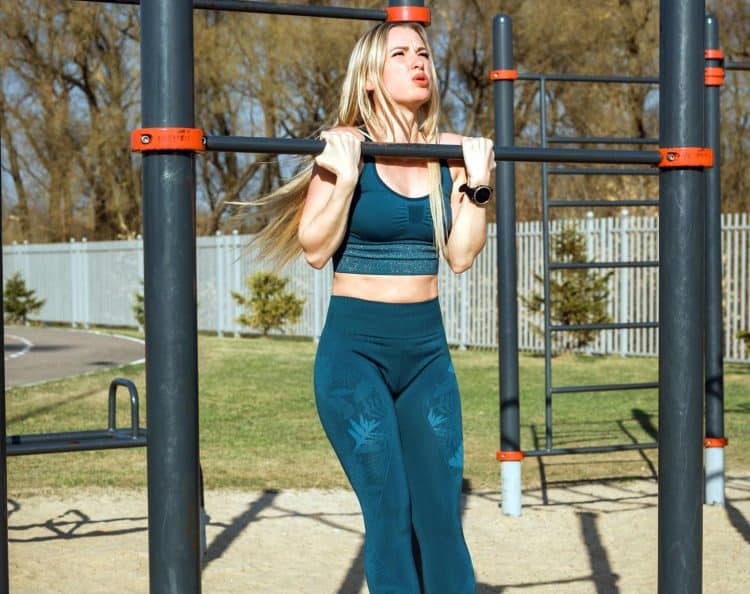Pull-ups and chin-ups are a staple in most strength training routines. They are also the exercises most beginners use to determine their strength level.
The pull-up and chin-up are compound (multi-joint) exercises that train your lats (primary) and abs, biceps, shoulders, and upper back (secondary).
Performing a pull-up and chin-up requires upper body strength. Anyone who doesn’t have strong arms, shoulders, back, and core cannot perform a bodyweight pull-up.
Most people confuse both exercises and use them interchangeably. Ask a rookie about the difference between the two, and they’ll probably tell you that both exercises are the same, except that in a chin-up, you’re supposed to take your chin over the pull-up bar. While in the other movement, you only have to bring your face to the bar’s level.
However, the grip is the only difference between the two exercises. While performing a pull-up, you need to grab the bar with a shoulder-wide overhand (pronated) grip. On the other hand, a chin-up requires you to grip the pull-up bar with an underhand (supinated) grip.
Notably, both variations require you to pull your chest as close to the pull-up bar as possible.
A majority of exercisers find chin-ups to be the easier alternative as it involves greater biceps recruitment than the conventional pull-up. Nonetheless, some lifters might prefer the pull-up over the chin-up due to their training regimen, body proportions, and muscle firing patterns.
In this article, you’ll learn about the average pull-up and chin-up by gender, weight, and experience level, how to perform the exercises with the correct form, and get better at the lift.
Average Pull-Up By Weight, Experience Level, and Gender
The pull-up and chin-up are harder than they are usually given credit for. Both exercises require you to pull your body weight against gravity. You’ll hardly ever see people using ginormous added resistance on the pull-up and chin-up.
Factors like your body weight, experience level, and gender can have a role in determining how much weight you can pull.
The tables below will help you find how you stack up against lifters at your level. The numbers below represent the one-rep max (1RM) for people at different experience levels and weight classes.
[sc name=”style-blue-box” ]
Note: The weights mentioned in the tables below represent added resistance. For example, +100 means body weight plus hundred pounds. On the other hand, a negative number (-10) represents a 10-pound assistance, translating to body weight minus ten pounds.
[/sc]
Average Pull-Up For a Man

The average male pull-up depends on several factors, including a lifter’s age, weight, and experience level.
Below is the Male Pull-Up Standards chart from Symmetric Strength:
[sc name=”TableNoWrap”]
| Body Weight (pounds) | Untrained | Novice | Intermediate | Proficient | Advanced | Exceptional | Elite | World Class |
| 114 | +0 | +25 | +45 | +65 | +85 | +110 | +130 | +150 |
| 123 | +0 | +25 | +45 | +70 | +90 | +115 | +135 | +155 |
| 132 | +5 | +25 | +50 | +75 | +100 | +125 | +145 | +170 |
| 148 | +0 | +25 | +50 | +75 | +100 | +125 | +150 | +175 |
| 165 | +0 | +25 | +50 | +80 | +105 | +135 | +160 | +180 |
| 181 | -5 | +25 | +50 | +80 | +105 | +135 | +165 | +185 |
| 198 | -5 | +20 | +45 | +75 | +105 | +135 | +160 | +185 |
| 220 | -10 | +15 | +45 | +70 | +110 | +130 | +160 | +185 |
| 242 | -10 | +15 | +40 | +65 | +95 | +125 | +155 | +180 |
| 275 | -15 | +5 | +30 | +55 | +80 | +110 | +140 | +170 |
| 320 | -25 | -5 | +20 | +40 | +65 | +85 | +115 | +145 |
[/sc]
Unlike the deadlift, squat, or bench press, the performance of an average untrained male on the chin-up and pull-up is negatively correlated to their bodyweight, especially after they cross the 165-pound mark.
After a linear rise, the added resistance used by beginners to world-class athletes plateaus at the 198 to 220-pound range and then drops off for heavier folks. Notably, lifters in the 242 to 320-pound group end up pulling more than their lighter peers because of their bigger structures.
Average Pull-Up For a Woman

Women’s pull-up performance, too, is linked to their weight, age, and experience level.
Below is the Female Pull-Up Standards chart from Symmetric Strength:
[sc name=”TableNoWrap”]
| Body Weight (pounds) | Untrained | Novice | Intermediate | Proficient | Advanced | Exceptional | Elite | World Class |
| 97 | -20 | -5 | +10 | +25 | +35 | +50 | +65 | +75 |
| 105 | -25 | -10 | +5 | +20 | +35 | +50 | +65 | +75 |
| 114 | -30 | -10 | +5 | +20 | +35 | +50 | +65 | +75 |
| 123 | -30 | -15 | +0 | +15 | +30 | +50 | +65 | +80 |
| 132 | -25 | -10 | +5 | +20 | +35 | +50 | +70 | +85 |
| 148 | -30 | -20 | +0 | +15 | +30 | +50 | +65 | +80 |
| 165 | -30 | -20 | -5 | +15 | +30 | +50 | +70 | +85 |
| 181 | -30 | -20 | -5 | +15 | +30 | +45 | +65 | +85 |
| 198 | -35 | -25 | -10 | +5 | +20 | +40 | +60 | +75 |
| 205 | -35 | -25 | -10 | +5 | +20 | +40 | +60 | +75 |
[/sc]
Compared to their male counterparts, untrained and beginner female lifters are considerably weaker at the pull-up. They match their untrained male peers at the intermediate experience level in relative strength.
Furthermore, the difference in added resistance for an average world-class female athlete in the 97 to 205-pound bodyweight range is just 10 pounds, meaning the upper body strength on the exercise doesn’t change significantly with a rise in bodyweight. Meanwhile, the pull-up added resistance fluctuates by 40 pounds for male world-class athletes.
Overall Average Male and Female Pull-Up
Here is what the overall average pull-up weight for males and females looks like:
Overall Average Male Pull-Up

Per the Centers for Disease Control and Prevention’s National Center for Health Statistics (CDC), an average American male weighs 197.8 pounds, meaning an average man who doesn’t lift could perform a single pull-up with a five-pound assistance. On the other hand, an average rookie lifter could pull 20 pounds of added resistance for one rep. [1]
The average added resistance on a pull-up for an American intermediate lifter is 45 pounds, 75 pounds for proficient, 105 pounds for advanced, 135 pounds for exceptional, 160 pounds for elite, and 185 pounds for world-class athletes.
Overall Average Female Pull-Up
Per the CDC data, an average American female tips the scales at 170.5 pounds. As per the table from Symmetric Strength, a 165-pound woman (closest to 170.5 pounds) with no lifting experience would need a 30-pound assistance to complete a single pull-up, while a novice lifter would require a 20-pound assistance.
Furthermore, an average intermediate lifter would require a five-pound assistance to complete a pull-up. On the other hand, an average proficient lifter could perform a pull-up with 15 pounds of additional resistance, 30 pounds for advanced, 50 pounds for exceptional, 70 pounds for elite, and 85 pounds for world-class athletes.
Average Chin-Up By Weight, Experience Level, and Gender
While pull-up and chin-up are similar exercises, the weight you can use in each exercise differs due to different grips. A lifter can, on average, lifter heavier on the chin-up than the conventional pull-up due to greater biceps engagement.
Average Chin-Up For a Man

Like the pull-up, the average male chin-up depends on several factors, including a lifter’s age, weight, and experience level.
Below is the Male Chin-Up Standards chart from Symmetric Strength:
[sc name=”TableNoWrap”]
| Body Weight (pounds) | Untrained | Novice | Intermediate | Proficient | Advanced | Exceptional | Elite | World Class |
| 114 | +5 | +30 | +50 | +75 | +95 | +115 | +140 | +160 |
| 123 | +5 | +25 | +50 | +75 | +100 | +125 | +145 | +165 |
| 132 | +5 | +30 | +55 | +85 | +110 | +135 | +155 | +180 |
| 148 | +0 | +25 | +55 | +85 | +110 | +135 | +160 | +185 |
| 165 | +5 | +30 | +55 | +85 | +115 | +145 | +170 | +195 |
| 181 | +0 | +30 | +55 | +90 | +120 | +150 | +175 | +200 |
| 198 | -5 | +20 | +50 | +80 | +115 | +145 | +170 | +200 |
| 220 | -5 | +20 | +45 | +80 | +110 | +145 | +170 | +200 |
| 242 | -10 | +20 | +45 | +75 | +105 | +140 | +170 | +195 |
| 275 | -15 | +10 | +35 | +60 | +90 | +120 | +155 | +185 |
| 320 | -25 | +5 | +25 | +45 | +70 | +100 | +130 | +160 |
[/sc]
Untrained and novice males, on average, can lift the same amount on the pull-up and chin-up. However, there is a linear improvement in the performance of male lifters from the intermediate experience level up to the world-class level.
Average Chin-Up For a Woman
Women’s chin-up performance, too, is linked to their weight, age, and experience level.

Below is the Female Chin-Up Standards chart from Symmetric Strength:
[sc name=”TableNoWrap”]
| Body Weight (pounds) | Untrained | Novice | Intermediate | Proficient | Advanced | Exceptional | Elite | World Class |
| 97 | -20 | -5 | +10 | +25 | +40 | +55 | +70 | +85 |
| 105 | -25 | -10 | +10 | +25 | +40 | +55 | +70 | +80 |
| 114 | -25 | -10 | +5 | +25 | +40 | +55 | +70 | +85 |
| 123 | -30 | -10 | +5 | +20 | +35 | +55 | +70 | +85 |
| 132 | -25 | -10 | +10 | +25 | +40 | +60 | +75 | +90 |
| 148 | -30 | -15 | +0 | +20 | +35 | +55 | +75 | +90 |
| 165 | -30 | -15 | +0 | +20 | +35 | +55 | +75 | +90 |
| 181 | -30 | -15 | +0 | +30 | +35 | +55 | +75 | +90 |
| 198 | -35 | -25 | -10 | +10 | +30 | +50 | +70 | +85 |
| 205 | -35 | -25 | -5 | +10 | +30 | +50 | +70 | +85 |
[/sc]
While an average man’s strength on the chin-up increases with experience level compared to the pull-up, it is not the same for women.
Untrained women, on average, require a 30-pound assistance on both — chin-up and pull-up. However, women can usually pull five pounds more on the chin-up than the pull-up.
Overall Average Male and Female Chin-Up
Here is what the overall average chin-up weight for males and females looks like:
Overall Average Male Chin-Up
An average American male weighing 197.8 pounds who doesn’t lift requires a five-pound assistance to complete a chin-up. However, a novice lifter could perform a chin-up with 20 pounds of added resistance.
Moreover, intermediate lifters could pull 50 pounds of additional resistance, 80 pounds for proficient, 115 pounds for advanced, 145 pounds for exceptional, 170 pounds for elite, and 200 pounds for world-class athletes.

Overall Average Female Chin-Up
An average American female tipping the scales at 165 pounds (closest to 170.5 pounds) with no lifting experience would need a 30-pound assistance to complete a single pull-up. A novice lifter would require a 15-pound assistance, and an average intermediate lifter could perform a single bodyweight pull-up without help.
On the other hand, an average proficient lifter could perform a pull-up with 20 pounds of additional resistance, 35 pounds for advanced, 55 pounds for exceptional, 75 pounds for elite, and 90 pounds for world-class athletes.
How to Perform a Pull-Up
This is how to perform a pull-up with the correct form:
- Grab the bar with a wider than shoulder width overhand (pronated) grip while standing on an elevated platform.
- Roll your shoulders back and down by bringing your shoulder blades together.
- Step off the platform so that you are hanging from the bar.
- You can cross your feet behind you or keep them directly under you.
- Raise your chest toward the bar by engaging your lats. Keep your elbows and shoulders in line with the bar.
- Raise yourself until your chest is close to the bar.
- As your head approaches the bar, lean back slightly so your face clears the bar.
- Pause and contract at the top.
- Return to the starting position in a slow and controlled motion.
- Repeat for desired reps.
Check out our pull-up guide to learn how to perform the exercise for achieving muscle hypertrophy.
How to Perform a Chin-Up
Follow the steps laid below to get the best bang for your buck while performing the chin-up:
- Hang from the bar using a shoulder-wide underhand (supinated) grip.
- Keep your core engaged throughout the exercise to avoid swinging and using momentum.
- Squeeze together your shoulder blades and pull them down as if performing a reverse shrug.
- Lift your chest towards the horizontal bar by bending at your elbows.
- Raise yourself until your head has cleared the bar.
- Pause and contract at the top.
- Slowly return to the starting position.
- Repeat for desired repetitions.
Check out our chin-up guide to dig deep into the exercise and learn about its variations and alternatives.
How To Get Better at Pull-Up and Chin-Up
Given below are steps to get better at both lifts:
- Assisted Pull-Ups: If you cannot perform a bodyweight pull-up, you should use the assisted pull-up machine or resistance bands to build upper-body strength.
- Dead Hangs: Dead hangs involve hanging onto a bar — with a pronated or supinated grip — for as long as possible. It helps build the forearm and grip strength required for performing a bodyweight pull-up or chin-up.
- Scapula Pulls: This exercise helps build shoulder strength, which can translate to an unassisted pull-up.
- Negatives: In this technique, your chest will be close to the bar at the starting position. You could jump to get in position or ask your training partner for a spot. Negatives help build upper body strength.
FAQs
Which is better? Pull-up or chin-up?
Both exercises target your muscles differently and deserve a place in your training regimen. You could alternate between the two to ensure you’re not leaving gains on the table.
Can I perform pull-ups every day?
Yes. Arnold Schwarzenegger performed 50 chin-ups as a warm-up on his upper-body training days. There is no reason why you shouldn’t do the same.
You might also like:
- Average Bench Press By Age, Weight, Gender, and Experience Level
- Average Deadlift By Weight, Gender, and Experience Level
- Average Squat By Weight, Gender, and Experience Level
- Average Power Clean By Weight, Gender, and Experience Level
- Average Thigh Circumference in Males and Females
- The Average Calf Size for Men and Women
- Average Waist Size For Women and Men
- Average Biceps Size: How Do You Measure Up?
Wrapping Up
Pull-ups and chin-ups are incredibly effective upper body exercises and should be a part of every exerciser’s training regimen. They help build functional strength and can add to the width of your back.
Use the charts above to check how you stack up against folks in your weight class and experience level. Alternate between both exercises to get the best of both worlds.
References
- McDowell MA, Fryar CD, Ogden CL, Flegal KM. Anthropometric reference data for children and adults: United States, 2003–2006. National health statistics reports; no 10. Hyattsville, MD: National Center for Health Statistics. 2008.


